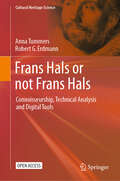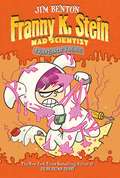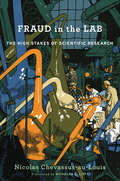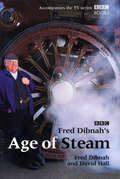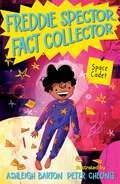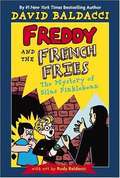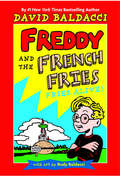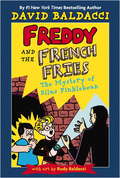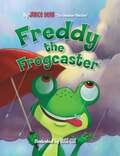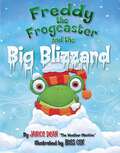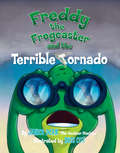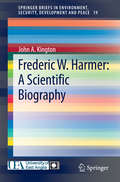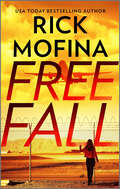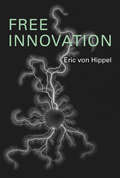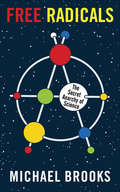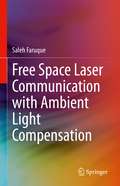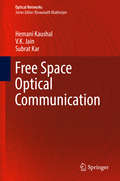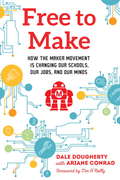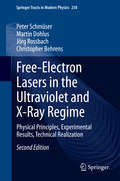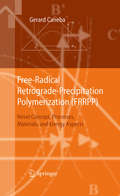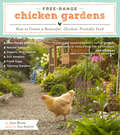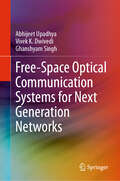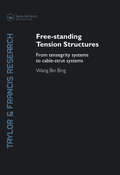- Table View
- List View
Frans Hals or not Frans Hals: Connoisseurship, Technical Analysis and Digital Tools (Cultural Heritage Science)
by Anna Tummers Robert G. ErdmannFrans Hals is hailed as one of the three greatest painters of the Dutch seventeenth century along with Rembrandt and Vermeer. Of all seventeenth-century Dutch painters, Frans Hals is also the most controversial in as far as the exact scope of his oeuvre is concerned. Hals’s popularity, the lack of technical reference material as well as the differing views among experts as to the exact scope of his oeuvre make works in his style prone to doubts and misattributions. It has led to fierce debates and legal battles about the attribution of paintings done in his style. In this Open Access book, experts from Ghent University, Leiden University, Amsterdam University, Delft University of Technology, the Frans Hals Museum (Haarlem), the Rijksmuseum (Amsterdam), the Gemäldegalerie (Berlin) and the Metropolitan Museum of Art (New York) give surprising new insights into some of Hals’s most well-known paintings as well as into some of the most fiercely contested pictures in his style. Their insights result from in-depth study of a wealth of reference material: seventeenth-century sources, advanced technical analyses and newly developed digital visualisation tools. “Tummers and Erdmann have produced a work of ground-breaking new scholarship. They combine in-depth art historical study with new technical analyses and data visualisation tools in order to solve current issues in the attribution of paintings by Frans Hals. This book significantly sharpens our understanding of Hals’s virtuoso work process, his characteristic workshop practice, and his notion of authenticity. The rich data gathered for the case studies will be useful for a next generation of art historians and connoisseurs: digital tools enhance the human eye in matters of attribution.” Prof. Thijs Weststeijn, Professor of Art History before 1800, Utrecht University "Tummers bravely interrogates the history of connoisseurship and the seemingly never-ending search for attributions of paintings associated with Frans Hals. A series of well-chosen case studies of paintings rigorously subjected to the most current means of examination and scientific imaging by leading experts in the field extends our understanding of Hals, his manner of painting, and the possibilities for aligning traditional connoisseurship with technical studies and techniques. In the process, this book thoughtfully probes the merits, challenges, and potential of 21st-century digital tools alongside the role of visual analysis." Christopher D.M. Atkins, Van Otterloo-Weatherbie Director of the Center for Netherlandish Art at the Museum of Fine Arts, Boston
Frantastic Voyage (Franny K. Stein, Mad Scientist #5)
by Jim BentonGoosebumps and Bill Nye the Science Guy fans, meet Franny!Franny&’s faithful Lab assistant, Igor, has swallowed a doomsday device that is ready to go off at any moment! For a regular scientist, it might seem like there&’s only one way to get the device out—um...make that two ways. But Franny K. Stein is no ordinary scientist, so she concocts her own way to get the device back and save her friend. With her miniaturization machine, Franny shrinks herself to the size of a pin and goes on a field trip like no other...through the body of a ticking time-dog! Fasten your seat belts, it&’s going to be a bumpy ride!
Fraud in the Lab: The High Stakes of Scientific Research
by Nicolas Chevassus-au-LouisFrom manipulated results and fake data to retouched illustrations and plagiarism, cases of scientific fraud have skyrocketed in the past two decades. In a damning exposé, Nicolas Chevassus-au-Louis details the circumstances enabling the decline in scientific standards and highlights efforts to curtail future misconduct.
Fred Dibnah's Age Of Steam
by David Hall Fred DibnahBritains favourite steeplejack and industrial enthusiastic, the late Fred Dibnah, takes us back to the 18th century when the invention of the steam engine gave an enormous impetus to the development of machinery of all types. He reveals how the steam engine provided the first practical means of generating power from heat to augment the old sources of power (from muscle, wind and water) and provided the main source of power for the Industrial Revolution. In Fred Dibnahs Age of Steam Fred shares his passion for steam and meets some of the characters who devote their lives to finding, preserving and restoring steam locomotives, traction engines and stationary engines, mill workings and pumps. Combined with this will be the stories of central figures of the time, including James Watts - inventor of the steam engine - and Richard Trevithick who played a key role in the expansion of industrial Britain in the 18th and 19th centuries.
Fred Sanger Double Nobel Laureate
by George G. BrownleeConsidered 'the father of genomics', Fred Sanger (1918-2013) paved the way for the modern revolution in our understanding of biology. His pioneering methods for sequencing proteins, RNA and, eventually, DNA earned him two Nobel Prizes. He remains one of only four scientists (and the only British scientist) ever to have achieved that distinction. In this, the first full biography of Fred Sanger to be published, Brownlee traces Sanger's life from his birth in rural Gloucestershire to his retirement in 1983 from the Medical Research Council's Laboratory of Molecular Biology in Cambridge. Along the way, he highlights the remarkable extent of Sanger's scientific achievements and provides a real portrait of the modest man behind them. Including an extensive transcript of a rare interview of Sanger by the author, this biography also considers the wider legacy of Sanger's work, including his impact on the Human Genome Project and beyond.
Freddie Spector, Fact Collector: Space Cadet
by Ashleigh BartonDid you know that a bolt of lightning is five times hotter than the Sun? Or that slugs have four noses? How about that humans share 50 per cent of our DNA with bananas? Freddie Spector, the world's greatest fact collector, knows all these things and so much more.Freddie Spector loves collecting facts - about anything and everything. His latest obsession is space. It's all he talks about: stars, planets, galaxies, astronauts, space travel - and, of course UFOs and extraterrestrials. Freddie writes all his facts on sticky notes that his mum and big sister, Henrietta, keep finding in weird places - like in their sock drawers or their sandwiches.But whenever Freddie collects facts on a topic, his very active imagination always gets involved too. And, after noticing some very suspicious goings-on, Freddie realises it's up to him to discover the answer to a burning question: could aliens have landed in his neighbourhood?Fast-paced and funny, this series is all about an everyday eight-year-old boy whose love of facts and extraordinary imagination come together with unexpected and hilarious results.
Freddie and the French Fries #2: The Mystery of Silas Finklebean
by David BaldacciTHE FAB FRIES RETURN FOR ANOTHER WACKY CAPER--THROUGH TIME AND SPACE! The Gang: Freddy T. Funkhouser, science whiz kid; Howie Kapowie, his cheese-cube-chowing sidekick; and Freddy's most incredible inventions: five living, breathing French fries by day, superpowered kick-butt spuds by night! The Plan: Use the secret notes of mysterious missing inventor Silas Finklebean to construct a time travel machine (from a pile of junk) that sweeps the annual science competition and creams Pookesville's baddest bully, Adam Spanker, once and for all. The Big questions: Will Freddy's time-warp team beat the clock before Adam's exploding volcano buries the Funkhouser family restaurant, the Burger Castle, in goopy purple lava? And can they finally crack the case of the long-lost Silas Finklebean? Bestselling author David Baldacci cooks up another scrumptious adventure, this time stirring in a dash of spooky mystery and zany science fiction, and topping it with a big helping of laughs!
Freddy and the French Fries #1: Fries Alive! (Freddy and the French Fries #1)
by David Baldacci Arudy BaldacciA master crafter of thrills, bestselling novelist David Baldacci shows his tremendous talent for side-splitting storytelling in this hilarious adventure about fame, friends, and family. Here is the story where readers first met Theodore, Wally, Curly, Ziggy, Si, and Meese (French fries so lovable you won't want to eat them!). But shoestring, waffle, wedge, curly, and crinkle-cut potatoes were never more irresistible than in this zany adventure about five giant fries that come to life--well, six if you count heads. It all begins when Freddy Funkhauser, an offbeat nine-year-old with a knack for science, embarks on an ambitious plan to win new customers for the family business, The Burger Castle. But when his secret invention ends up working better than he'd ever dreamed, his plans go wildly awry as his kooky companions wreak havoc in every corner of Freddy's world!
Freddy and the French Fries #2: The Mystery of Silas Finklebean (Freddy and the French Fries #2)
by David BaldacciIn this sequel to "Fries Alive!," Freddy Funkhauser discovers the lab of long-lost scientist Silas Finklebean, along with instructions on how to build a time machine. With Finklebean's help, Freddie is determined to prove himself to bully Adam Spanker.
Freddy the Frogcaster
by Janice DeanFreddy the Frog loves learning about the weather, and he's known for having the best predictions in town. But what happens when the town picnic is almost ruined by a storm that catches the local frogcaster by surprise? Freddie has to step in to save the day! Well-known Fox News broadcast meteorologist Janice Dean pens this exciting and hilarious tale about an aspiring weathercaster who can't keep his eyes off the sky. Children and adults will love the charming frog world Freddy lives in, and the fun science lessons he shares, with an activities section in the back
Freddy the Frogcaster and the Big Blizzard
by Janice DeanFreddy the Frog loves learning about the weather, and he’s known for having the best predictions in town. But what happens when a blizzard rolls in?
Freddy the Frogcaster and the Terrible Tornado
by Janice DeanGet ready for a whirlwind of adventure with Freddy the Frogcaster when a famous storm chaser visits Lilypad! In her fourth book, well-known meteorologist Janice Dean tackles some scary weather. Freddy the Frogcaster is faced with one of the most ferocious and devastating kinds of weather: the tornado. Young readers will learn all about how big storms occur and produce some of nature's most destructive weather. Chock-full of storm science lessons in the back, children and adults alike will learn valuable life-saving information. As Freddy reminds us, please be prepared and know what to do and where to go when the next bad storm comes your way! <p><p> <i>Advisory: Bookshare has learned that this book offers only partial accessibility. We have kept it in the collection because it is useful for some of our members. To explore further access options with us, please contact us through the Book Quality link on the right sidebar. Benetech is actively working on projects to improve accessibility issues such as these. </i>
Frederic W. Harmer: A Scientific Biography
by John A. KingtonComprising the first definitive account of the geological and palaeometeorological studies made by the British geologist, Frederic W. Harmer (1835-1924) this book contributes a previously missing chapter to the history of science. The main objective of the author is to ensure that the scientific work of Harmer, which unfortunately has been widely neglected or forgotten, becomes more generally known and acknowledged. The balance of this deficiency will be redressed by bringing to light in this volume his contributions to the history of science to an audience of academic and lay readers of the current literature.
Free Culture: How Big Media Uses Technology and the Law to Lock Down Culture and Control Creativity
by Lawrence LessigDiscusses the ramifications of copyright law for culture. The author of this book donated a digital copy of this book. Join us in thanking Lawrence Lessig for providing his accessible digital book to this community.
Free Fall (Kate Page)
by Rick Mofina“A terrifying race against time as airplanes start falling out of the sky for unknown reasons . . . The kind of thriller that keeps you up late.” —The Big ThrillHigh above the Adirondack Mountains, a commuter flight to New York City turns into a rolling, twisting nightmare, plunging from the sky before the crew regains control. Then, in London, a jetliner crashes into the runway, killing fifteen people.Reporter Kate Page believes something beyond mechanical—or human—error is behind the incidents that have air investigators baffled. But the mystery deepens as teams scramble to pinpoint a link between the tragedies, and Kate receives an untraceable message from someone boasting responsibility and threatening another event.As Kate, the FBI and the NTSB race to find answers, the shadow figures behind the operation launch their most devastating plan yet, and time ticks down on one of the greatest tragedies the world has ever known.“Journalist Kate Page, one of Rick Mofina’s best characters, is back in this high-paced novel with a scary theme . . . Mofina is at his best here with technical knowledge and a solid investigation underpinning a plot that we can all connect to. Do not read this one before getting on a plane.” —The Globe and Mail“A chilling account of two airliners making routine flights but losing control as they approached their landing sites . . . a complex suspense thriller . . . a pulse-pounding story.” —Mysterious Reviews
Free Innovation (The\mit Press Ser.)
by Eric Von HippelA leading innovation scholar explains the growing phenomenon and impact of free innovation, in which innovations developed by consumers and given away “for free.”
Free Radicals: The Secret Anarchy of Science
by Michael Brooks&“An exuberant tour through the world of scientists behaving badly&” (The New York Times). They may have a public image as cool, logical, levelheaded types. But in reality, scientists will do pretty much anything—take drugs, follow mystical visions, lie, and even cheat—to make a discovery. In Free Radicals, physicist and journalist Michael Brooks seamlessly weaves together true stories of the &“mad, bad and dangerous&” men and women who have revolutionized the scientific world, and offers a fast-paced and thrilling exploration of the real process behind discovery (The Times, London). Brooks also traces the cover-up back to its source: the scientific establishment&’s reaction to the public fear of science after World War II. He argues that it its high time for science to come clean about just how bold and daring scientists really are. &“Not all scientists are nerds. In Free Radicals, physicist Michael Brooks tries to dispel the notion that scientists are stuffy, pen-protector-polishing bookworms.&” —The Washington Post &“Insightful . . . A page-turning, unvarnished look at the all-too-human side of science.&” —Kirkus Reviews
Free Space Laser Communication with Ambient Light Compensation
by Saleh FaruqueThis book addresses 5G network capacity requirements with a new architecture for 5G Optical Backhaul Network. The author first describes the challenges for 5G backhaul network requirements and then the details of an Optical Backhaul Network for 5G. The author describes an architecture, in which small cells deploy as a cluster (i.e., 3-5 small cells in one cluster), where one small cell works as an aggregation point using an optical transceiver to backhaul the aggregated traffic to the nearest optical network unit, before it then goes to the core network. This book also illustrates the optical link budget analysis that can be used to determine the availability and the performances of the optical backhaul link in different deployment scenarios and different weather conditions. Provides a single-source reference to the basics of free space laser communication with ambient light compensation;Offers timely information, blending theory and practice;Written to be accessible to readers with varying backgrounds, including numerous illustrations;Provides hands-on experience through practical examples, which can be put to work to deploy and optimize cellular networks.
Free Space Optical Communication
by Hemani Kaushal V. K. Jain Subrat KarThis book provides an in-depth understanding of free space optical (FSO) communication with a particular emphasis on optical beam propagation through atmospheric turbulence. The book is structured in such a way that it provides a basic framework for the beginners and also gives a concise description from a designer's perspective. The book provides an exposure to FSO technology, fundamental limitations, design methodologies, system trade-offs, acquisition, tracking and pointing (ATP) techniques and link-feasibility analysis. The contents of this book will be of interest to professionals and researchers alike. The book may also be used as a textbook for engineering coursework and professional training.
Free to Make: How the Maker Movement is Changing Our Schools, Our Jobs, and Our Minds
by Tim O'Reilly Dale Dougherty Ariane ConradDale Dougherty, creator of MAKE: magazine and the Maker Faire, provides a guided tour of the international phenomenon known as the Maker Movement, a social revolution that is changing what gets made, how it's made, where it's made, and who makes it. Free to Make is a call to join what Dougherty calls the "renaissance of making," an invitation to see ourselves as creators and shapers of the world around us. As the internet thrives and world-changing technologies--like 3D printers and tiny microcontrollers--become increasingly affordable, people around the world are moving away from the passivity of one-size-fits-all consumption and command-and-control models of education and business. Free to Make explores how making revives abandoned and neglected urban areas, reinvigorates community spaces like libraries and museums, and even impacts our personal and social development--fostering a mindset that is engaged, playful, and resourceful. Free to Make asks us to imagine a world where making is an everyday occurrence in our schools, workplaces, and local communities, grounding us in the physical world and empowering us to solve the challenges we face.From the Trade Paperback edition.
Free-Electron Lasers in the Ultraviolet and X-Ray Regime
by Peter Schmüser Martin Dohlus Jörg Rossbach Christopher BehrensThe main goal of the book is to provide a systematic and didactic approach to the physics and technology of free-electron lasers. Numerous figures are used for illustrating the underlying ideas and concepts and links to other fields of physics are provided. After an introduction to undulator radiation and the low-gain FEL, the one-dimensional theory of the high-gain FEL is developed in a systematic way. Particular emphasis is put on explaining and justifying the various assumptions and approximations that are needed to obtain the differential and integral equations governing the FEL dynamics. Analytical and numerical solutions are presented and important FEL parameters are defined, such as gain length, FEL bandwidth and saturation power. One of the most important features of a high-gain FEL, the formation of microbunches, is studied at length. The increase of gain length due to beam energy spread, space charge forces, and three-dimensional effects such as betatron oscillations and optical diffraction is analyzed. The mechanism of Self-Amplified Spontaneous Emission is described theoretically and illustrated with numerous experimental results. Various methods of FEL seeding by coherent external radiation are introduced, together with experimental results. The world's first soft X-ray FEL, the user facility FLASH at DESY, is described in some detail to give an impression of the complexity of such an accelerator-based light source. The last chapter is devoted to the new hard X-ray FELs which generate extremely intense radiation in the Angstrøm regime. The appendices contain supplementary material and more involved calculations.
Free-Radical Retrograde-Precipitation Polymerization (FRRPP)
by Gerard CanebaThe book pertains to unique phenomenological features of a potentially runaway polymerization reaction process that is apparently brought under control through a mass and energy confining mechanism. It integrates the combination of various concepts in order to explain a collection of experimental observations, which includes entrapment of reactive intermediates as well as their energy contents, nucleated thermal hot spots beyond adiabatic rise temperatures, and nanoscale confinement behavior that has been used for fine patterning of polymers. Toward the end, the author of the book will try to use whatever understanding that has been formulated about the Free-Radical Retrograde-Precipitation Polymerization (FRRPP) process to relate it to various materials including environmentally-reponsible and energy-relevant types, and inherent control of energetic systems.
Free-Range Chicken Gardens: How to Create a Beautiful, Chicken-Friendly Yard
by Kate Baldwin Jessi BloomMany gardeners fear chickens will peck away at their landscape, and chicken lovers often shy away from gardening for the same reason. But you can keep chickens and have a beautiful garden, too! In this essential handbook, award-winning garden designer Jessi Bloom offers step-by-step instructions for creating a beautiful and functional space and maintaining a happy, healthy flock. Free-Range Chicken Gardens covers everything a gardener needs to know, from the basics of chicken keeping and getting them acclimated to the garden, to how to create the perfect chicken-friendly garden design and build innovative coops.
Free-Space Optical Communication Systems for Next Generation Networks
by Ghanshyam Singh Abhijeet Upadhya Vivek K. DwivediThis book provides insights in the field of free-space optical (FSO) communication, which is considered the next frontier for future-generation, broadband wireless networks. The authors discuss various factors limiting practical implementations of the mixed radio frequency/free-space optical (RF/FSO) relaying technology, to determine the impact of important parameters on the performance of mixed RF/FSO relaying systems. The book presents the various generalized channel models that can be adopted to model RF and FSO link statistics. Further, it presents the modeling of amplify-and-forward (AF) and decode-and-forward (DF) forms of cooperative relaying schemes. This book enables readers to understand the various mitigation techniques that can be utilized in mixed RF/FSO relaying in order to improve the overall user experience. The authors discuss the importance of artificial intelligence and machine learning in the field of wireless optical communication systems. Finally, the optical wireless channel modeling using both CNN and LSTM model is explored with their potential to enhance the accuracy and reliability of channel estimation.
Free-Standing Tension Structures: From Tensegrity Systems to Cable-Strut Systems
by Binbing WangArchitects are constantly looking for new methods to create large indoor spaces unhindered by columns and other supports. Tensile and cable-strut structures are one method of producing such spaces. They also enable the creation of different shaped spaces allowing architects more scope for innovation. Free-standing Tension Structures: From Tensegrit
